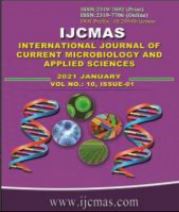


 National Academy of Agricultural Sciences (NAAS)
National Academy of Agricultural Sciences (NAAS)

|
PRINT ISSN : 2319-7692
Online ISSN : 2319-7706 Issues : 12 per year Publisher : Excellent Publishers Email : editorijcmas@gmail.com / submit@ijcmas.com Editor-in-chief: Dr.M.Prakash Index Copernicus ICV 2018: 95.39 NAAS RATING 2020: 5.38 |
The manipulation of crop geometry along with different levels of N, P and K is a time tested agronomic techniques to enhance the yield potential of cotton. In addition to the above, to facilitate mechanical harvesting, field experiments were conducted during summer season of 2019 and rabi season of 2019-20. The experiments were laid out in split plot design replicated thrice with four plant spacing in main plots viz., S1- 100 x 10 cm, S2-75 x15 cm, S3 -60 x15 cm and S4 -45 x15 cm and four levels of nutrient levels in sub plot viz., Control (without fertilizers), F1 - 100% RDF (80:40:40 kg of NPK ha-1), F2 -125% RDF (100:50:50 kg of NPK ha-1) and F3 -150% RDF (120:60:60 kg of NPK ha-1). The results from the pooled analysis (two season data) revealed that the nitrogen, phosphorus and potassium uptake were significantly influenced by the crop geometry and nutrient levels. The highest uptake of nitrogen 94.39 and 93.19 kgha-1 were recorded in S3F3 (60 x 15 cm with 150%RDF-120:60:60 kg NPK ha-1) and in S1F3 (100 x 10 cm with 150%RDF-120:60:60 kg NPK ha-1), respectively and were found to be on par with each other. These two treatments combination also registered highest uptake of phosphorous 15.47 kg ha-1 in S3F3 and 15.16 kg ha-1 in S1F3 and potassium 85.44 kg ha-1 in S3F3 and 84.24 kg ha-1 in S1F3. The maximum seed cotton yield of 2475 kg ha-1 was recorded in S3F2 (60 x 15 cm with 125%RDF-10:50:50 kg NPK ha-1) followed by S1F2 (60 x 15 cm with 150% RDF-120:60:60 kg NPK ha-1) which recorded 2395 kg ha-1 and were found to be on par.
 |
 |
 |
 |
 |